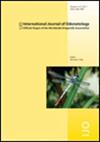Paleoecological niche modeling of Epiophlebia (Epiophlebioptera: Epiophlebiidae) reveals continuous distribution during the Last Glacial Maximum
IF 1
4区 农林科学
Q3 ENTOMOLOGY
引用次数: 0
Abstract
Disjunct biogeographic patterns of similar species remain enigmatic within evolutionary biology. Disparate distributions typically reflect species responses to major historical events including past climate change, tectonics, dispersal, and local extinction. Paleo-ecological niche modeling (PaleoENM) has proven useful in inferring the causes of disjunct distributions within charismatic and well-studied taxa including mammals, plants, and birds, but remains under-explored in insects. The relictual Asian dragonfly genus Epiophlebia (Suborder Epiophlebioptera: Epiophlebiidae) allows us a novel opportunity to explore PaleoENM in the context of disjunct distributions due to their endemism to the Japanese islands, Himalayas, China, and North Korea. The aim of this paper is to investigate the potential causes behind the modern distribution of Epiophlebia by inferring the historical range of these species within the Last Glacial Maximum (LGM), thereby highlighting the utility of PaleoENM in the context of odonate biogeography. Our results indicate possible past routes of gene flow of Epiophlebia during the LGM due to high habitat suitability of the genus stretching from the Himalayas to Japan. Furthermore, our results predict several unsampled areas which have the potential to harbor new populations of the genus.Epiophlebia(Epiophlebioptera: Epiophlebiidae)的古生态位建模揭示了其在末次冰河时期的连续分布情况
在进化生物学中,相似物种的不同生物地理格局仍然是一个谜。不同的分布通常反映了物种对重大历史事件的反应,包括过去的气候变化、构造、扩散和局部灭绝。古生态位建模(PaleoENM)已被证明有助于推断包括哺乳动物、植物和鸟类在内的魅力类群和研究充分的类群中物种分布不均衡的原因,但在昆虫中的研究仍然不足。亚洲的孑遗蜻蜓属 Epiophlebia(Epiophlebioptera 亚目:Epiophlebiidae)是日本列岛、喜马拉雅山、中国和朝鲜的特有种,这为我们提供了一个新的机会,在其分布不连续的背景下探索古全息模式。本文的目的是通过推断这些物种在末次冰川极盛时期(LGM)的历史分布范围,研究 Epiophlebia 现代分布背后的潜在原因,从而突出古ENM 在鸟类生物地理学中的作用。我们的研究结果表明,从喜马拉雅山到日本的Epiophlebia栖息地适宜性很高,因此在LGM期间Epiophlebia的基因流动路线可能是过去的。此外,我们的结果还预测了几个未采样地区,这些地区有可能孕育出该属的新种群。
本文章由计算机程序翻译,如有差异,请以英文原文为准。
求助全文
约1分钟内获得全文
求助全文
来源期刊

International Journal of Odonatology
ENTOMOLOGY-
CiteScore
2.30
自引率
0.00%
发文量
15
审稿时长
>12 weeks
期刊介绍:
International Journal of Odonatology (IJO) is aimed at providing a publication outlet for the growing number of students of Odonata. It will address subjects such as the ecology, ethology, physiology, genetics, taxonomy, phylogeny and geographic distribution of species. Reviews will be by invitation, but authors who plan to write a review on a subject of interest to the journal are encouraged to contact the editor.
 求助内容:
求助内容: 应助结果提醒方式:
应助结果提醒方式:


